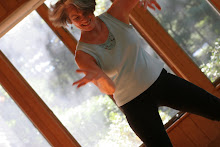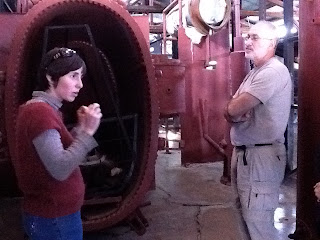| Tour from Haifa |
Breakfast
is holy in Israel. We had the usual fabulous
spread for breakfast at the Dan Carmel Hotel:
pastries
and bread, salads, fresh vegetables, fruit, halvah, hazelnut spread, cereal, cheeses,
yogurt, custom-cooked eggs, broccoli soufflé, French toast, coffee, juices, a great start to our first busy day.
Early
Monday morning, December 5, we were on the bus with our guide Ronny. Visible from our hotel balconies above, we viewed
the German colony below (moshav hagermanit) in Haifa up close, red tiled roofs,
tidy buildings. The Germans came as
Christian pilgrims, Templars, in 1868.
They later became sympathizers of Nazism. Ronny told us that the only two countries
where the Nazi flag was flown during WWII were Germany and Israel in Haifa’s
German Colony. That was surprising.
The
original village of Haifa was on the north side of the harbor, opposite our hotel
on the south side. Acco had a bigger harbor, but now there is a
need for a deep water harbor to accommodate international shipping and cruise ships. Haifa used to share the cruise industry with
Ashdod to the south, but due to the proximity of the Gaza strip and Palestinian
rockets capable of reaching Ashdod’s harbor, Haifa has taken over virtually all
of the cruise business in Israel. Haifa’s
Israeli army camp was built on an old British army camp site.
Haifa
has always had a mixture of Jews, Christians, and Muslims. Intel, Google, and Microsoft are now the
biggest private employers. Coexistence,
duk yum, is a watchwood in local politics.
British manipulation of Arab and Israeli conflicts, playing both ends
against the middle, exacerbated rather than mollified the inevitable
intercultural conflicts.
Rabbi
David Weiner asked us to hold up a mirror to our own lives, assess our degree
of success with coexistence in the Berkshires, among different religious
groups, socioeconomic groups, racial and cultural groups.
We
passed many banana fields with plants shaded by net tents and/or bags covering
the bunches of fruit. Fruit picked from
these plants can be in European markets on the same day. Winter agriculture is a profitable industry
in Israel.
Israeli
Arabs do not fly Israeli flags or sing the national anthem because of the Magen David
symbol and Zionist imagery. There is 20%
Arabic population in Israel. Between1882
and1900, 25,000 early pioneers came from Europe to settle the land, inspired by
Zionist ideology, prompting an outcry from the Arabs who inhabited the land. The Rothschild
family sent money and advisors for agriculture.
Zichron Jacov (remember Jacob Rothschild) is the name of a village. His advisors established the Carmel winery.
The
area is powered by coal. Nuclear energy
is not allowed by national policy because of its vulnerability to attack. There is a potential for lots of natural gas from
the Mediterranean, to be developed.
Egypt
exports oil and natural gas to Israel .
The pipeline in the desert has been blown up 6 times in the last
year. These destructive actions on the
part of current Egyptian activists is not in their own financial interest. Israel currently has a lot of questions about
what to expect of the emerging policies of the Muslim Brotherhood.
As
they say, In Jerusalem you pray, in Tel Aviv you play, in Haifa you work. There are many opportunities for business and
industry in Haifa: the harbor with
commercial shipping and tourist cruise ships, petrochemical and technology
industries, agriculture, fishing, tourism, high technology.
Blue
Macdonalds is kosher. The meat is
kosher; mixture is not kosher. There’s
no such thing as a kosher cheeseburger. Kosher
restaurants are either meat or dairy, not both.
Hotels all have kosher dining.
There is a growing industry of creating fake kosher foods.
Our
first stop is at the Givat Haviva retreat center, established in1949 for the
purpose of facilitating co-existence between Jews and Arabs in Israel. Arabs have a high birth rate. A Jewish woman produces 2.7 children, higher
than the American average of less than 2.
An Arab woman in Israel produces 4.0 children, 5.8 in the West
Bank.
Haviva
Reich is honored in the name of Givat Haviva.
She, Hannah Senesh, and Surika Braverman, trained together, but Hannah
Senesh is much better known. Haviva
Reich was responsible for having women inducted into the Israeli Defense Force.
Givat Haviva is located in a former
British army base.
The
600 seat auditorium is rented out for peace education events, and for other events
to increase revenues for the center.
Hundreds of soldiers were on hand for 5 weeks of remedial work after
high school before university, scattered around the grounds with firearms. Usually soldiers attending events at Givat
Haviva do not bring their weapons.
Another
event of the day was a paratrooper red beret conference. Each soldier has a “Catholic” marriage of
complete attention and fidelity to his gun.
A soldier who loses his gun could be imprisoned.
A
“peace tree” sculpture created by Arab and Israeli young people stands in a
prominent place.
The
Green Line, aka the1949 Line of Armistice, separates Israeli-controlled areas
from those with full or partial Palestinian control. Ralph Bunche, a black diplomat working for the
UN, created it. There are 160,000
Bedouins in the area who have not been nomadic for several generations. Tourists avoid this area. One village in the area made up of a single
extended family was divided by the green line, creating East Barta, a
Palestinian community, and West Barta, a community of Israeli Arabs. Muslim
men are allowed to take 4 wives, so more than one Barta husband had wives on
both sides of the Green Line.
The
Hashemite kingdom of Jordan has 70% Palestinians. Some Israeli Arabs prefer to call themselves Palestinians
with Israeli citizenship. Some Arab
Israelis are considered to be traitors by Palestinians when they do not fully
support the ambitions of the uprising.
Between 1967 and 1987, there has been a deepening of the identity
dilemma. Arab Israelis were happy with
the benefits they received from Israeli citizenship, did not want to break the
law, make trouble. The Oslo agreement
created big changes. During the year 2000
second intifada, Arab Israelis joined in for the first time.
Our
second stop was at the Atlit detention camp, the setting of Anita Diamant’s
novel Day After Night, which my Hadassah book club read in recent
years. In1917 during British rule of
Palestine, Arabs rebelled against immigration in response to the Balfour
declaration.
(From
Wikipedia) Aliyah Bet (Hebrew:
'עלייה ב, "Aliyah
'B'" - bet being the second letter of the Hebrew
alphabet) was the code name given to illegal immigration by Jews to the British Mandate for Palestine
in violation of British White Paper of 1939 restrictions, in the
years 1934-1948. In modern day Israel it has also been called by the Hebrew
term Ha'apala (Hebrew:
ההעפלה; ascension). The Aliyah Bet is
distinguished from the Aliyah Aleph ("Aliyah 'A'", Aleph
being the first letter of the Hebrew alphabet): the limited Jewish immigration
permitted by British authorities in the same period.
Aliyah
Bet brought 140,000 Jews who arrived by boat, by foot, by air. Small boats arrived with several hundreds, bigger
boats many hundreds more. A special
division of the British Mediterranean Navy was dedicated to keeping boats from
territorial waters. The1939 British white paper allowed
for 75,000 Jews to immigrate to Palestine in 5 years. After that quota was reached, no more would be allowed. New detention camps were created in Cypress to
house Jews on boats intercepted by the British navy. These
rickety boats were often floating coffins.
At
Atlit, genders were separated to prevent escape. They thought residents would not attempt escape
without the opposite-sex loved ones and family members. Those who escaped did so alone. People were released every month up to the
point where quotas were exceeded.
Refugees from European DP camps arrived in freight trains. With all the different languages represented,
there was litlle possibility of full explanations for what was happening to the
refugees. They were taken to disinfecting showers and
laundry first, a terrifying prospect for those who had been in European death
camps.
We
saw a remarkable sound and light show with photos, life-size tableaus, and
video, showing the conditions on the boats used to bring refugees to
Israel. I felt literally seasick when I
saw the waves through the video portholes on the boat.
The
Jews from Syria were released from Atlit because they were going to be returned
to Syria. Most Ashkenazic Jews were from
European countries to which there was no hope of return. There were many babies brought to Atlit, many
more born there.
Two
Jewish policemen were recruited to cooperate with Palmach and lead an escape October
10, 1945.
Between
1933 and1939, as the Nazis came to power,10,000 illegal immigrants arrived in
Palestine on 18 ships. There were 90,000
refugees in detention camps when the quotas were full. A 1947 ship, the "real” Exodus from
France, unlike its namesake in the Paul Newman movie, returned to its point of
departure, bringing its passengers back to Hamburg DP camps. Escape from Atlit was necessary because there
was no reasonable place to go back to and no hope of being released for settlement in
Israel.
As
we passed Arab villages on the highway, Ronny explained some differences
between Arab villages and Jewish settlements.
Arab villages are full of private homes and nothing else. There are no
apartment buildings, although an extended family might have a multi-family
building. Many of the homes are half
finished. Arabs often have a professional
contractor lay the foundation and then rely on family connections to supply the
rest of the work. Their standards for the interior of the house are quite high
for cleanliness and beauty. Outside the
house, e.g., landscaping, parking spaces, parks, common areas for the
community, are of less concern. The idea of having a pet inside the house is
shocking to them.
Jews
cannot buy a house in an Arab village. Even an Arab who is not a member of one
of the families in the village cannot purchase a house. When a new baby is born, construction of a
new story on top of the house is begun.
By the time that child is old enough to marry, his apartment will be
ready.
By
contrast, Jewish settlements have carefully planned landscaping designs, parks,
bike trails, walking paths, swimming pools, schools, synagogues, many common
areas for group activities.







0 Comments:
Post a Comment
Subscribe to Post Comments [Atom]
<< Home